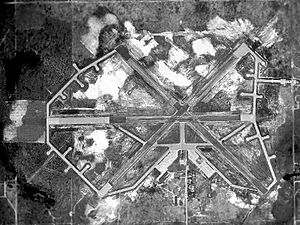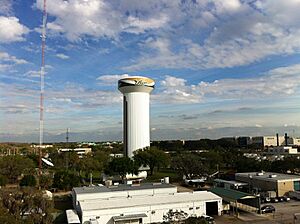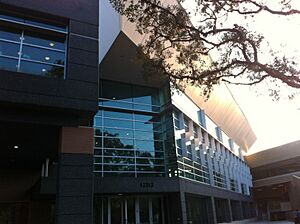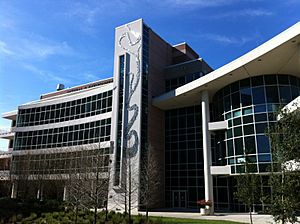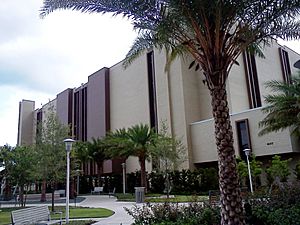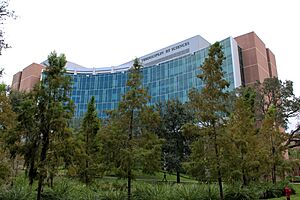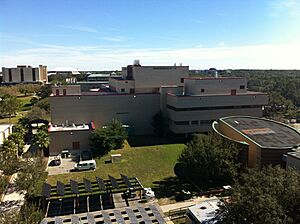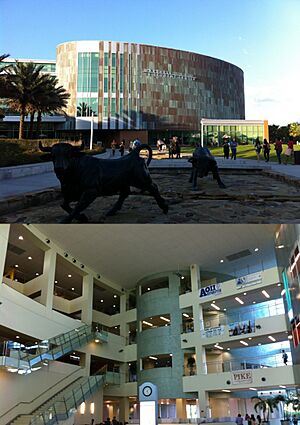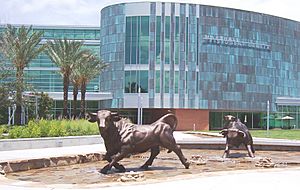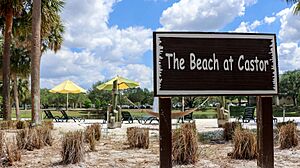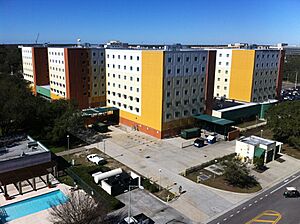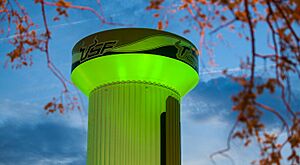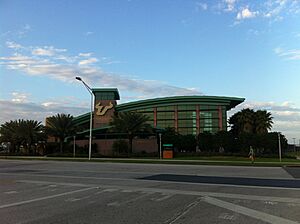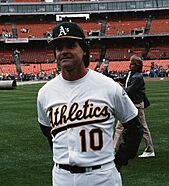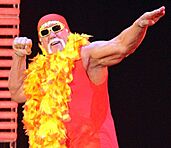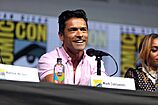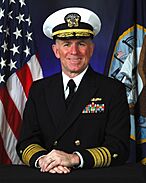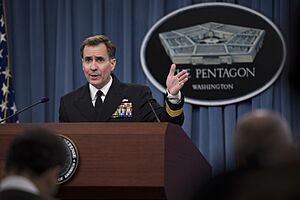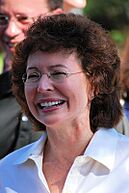University of South Florida facts for kids
 |
|
| Motto | "Truth and Wisdom" |
|---|---|
| Type | Public research university |
| Established | December 18, 1956 |
|
Parent institution
|
State University System of Florida |
| Accreditation | SACS |
|
Academic affiliations
|
|
| Endowment | $889 million (2024) |
| Budget | $2.80 billion (2024–2025) |
| President | Rhea Law |
| Provost | Prasant Mohapatra |
|
Academic staff
|
2,301 |
| Students | 48,732 (2023–2024) |
| Undergraduates | 36,452 (2023–2024) |
| Postgraduates | 10,802 (2023–2024) |
|
Other students
|
1,478 (2023–2024) |
| Location |
,
,
United States
|
| Campus | Large city, Total: 1,646 acres (6.7 km2) Tampa: 1,562 acres (6.3 km2) St. Petersburg: 52 acres (0.2 km2) Sarasota-Manatee: 32 acres (0.1 km2) |
| Other campuses |
|
| Newspaper | The Oracle |
| Colors | Green and gold |
| Nickname | Bulls |
|
Sporting affiliations
|
|
| Mascot | Rocky D. Bull |
 |
|
The University of South Florida (USF) is a large public university in Florida, United States. Its main campus is in Tampa. USF also has campuses in St. Petersburg and Sarasota. It is part of the State University System of Florida.
USF has 14 colleges and offers over 240 different degree programs. It is known for its high level of research activity. The university is also a member of the Association of American Universities (AAU).
USF was founded in 1956. It is the fourth-largest university in Florida by student numbers. As of the 2023–2024 school year, nearly 49,000 students from many countries and all U.S. states attend USF.
In 2022, the university's budget was over $2.3 billion. It spends a lot on research, ranking high nationally among public universities. USF also holds many U.S. patents, showing its focus on new inventions.
USF's sports teams are called the South Florida Bulls. They compete in NCAA Division I and have won many championships.
Contents
- USF's Story
- How USF is Led
- USF Campuses
- Learning at USF
- USF Libraries
- Research at USF
- Student Life
- University and Student Media
- USF Traditions
- USF Sports
- Famous People from USF
- Notable Faculty
- See also
USF's Story
Starting in the 1950s
USF was the first state university built in Florida during the 1900s. Samuel Gibbons, a former U.S. representative, helped a lot to create the school. Many call him the "Father of USF."
The university was founded in 1956, but it got its name in 1957. Classes started in 1960. USF was built on the site of an old World War II airstrip called Henderson Air Field. Before that, the area was a huge orange grove.
Growing in the 1960s
The first five buildings on campus included the old library and science building. The university was originally for white students only. However, it welcomed its first African-American student, Ernest Boger, in 1961. He graduated in 1964.
In 1962, students chose the "Golden Brahman" as the mascot. This was named after Florida's cattle industry. In the 1980s, the mascot changed to the "Bulls."
USF held its first graduation in 1963. About 325 students received degrees.
The first president, John S. Allen, led the university's fast growth. He was known for not wanting college sports at first. But USF's first sports teams began in 1965. The main administration building is now named after him and his wife, Grace.
The St. Petersburg campus opened in 1965. It was called the "Bay Campus" then. In 1966, a strong tornado damaged parts of the USF campus.
Changes in the 1970s
M. Cecil Mackey became the second president in 1970. He opened the university's medical school and first Ph.D. programs. He also helped the St. Petersburg campus grow and opened new campuses in Sarasota and Fort Myers.
The Sarasota–Manatee campus started in 1975. It shared a campus with New College of Florida for a while.
Developing in the 1980s
USF became a major research university under President John Lott Brown. The USF Graduate School was created in 1980. In 1986, the H. Lee Moffitt Cancer Center and Research Institute opened on the Tampa campus.
Francis T. Borkowski became the fourth president in 1988. He helped start the university's football program.
The 1990s and Beyond
Betty Castor became USF's first female president in 1994. During her time, USF became one of the largest universities in the country. The university's football team started playing in 1997.
Judy Genshaft became president in 2000. Under her leadership, USF became a top research university. It was recognized as a "preeminent" state research university in 2018. USF also became known as a veteran-friendly university.
In 2019, Steven C. Currall became president. USF moved into the top 50 public colleges in national rankings. He led the university through the COVID-19 pandemic.
In 2021, Rhea Law, a USF graduate, became interim president. She was then chosen as the permanent president in 2022. She is the first USF graduate to hold this role. Law aimed for USF to join the Association of American Universities, which it did in 2023.
In 2025, USF opened the Bellini College of Artificial Intelligence, Cybersecurity, and Computing. This was made possible by a large donation from Arnie and Lauren Bellini.
USF's Seal and Colors
In 1958, President John Allen asked for a special symbol for the university. This symbol, the USF seal, was meant to show education around the world.
USF's first colors were green, gold, and purple. Purple was later removed, making green and gold the main colors. However, purple can still be seen on some older buildings. It has also returned as a small accent color for some women's sports teams.
Preeminent Status
In 2018, USF was named a "Preeminent university" in Florida. This means it met many high standards set by the state. This status helps USF get more funding for research and academics.
How USF is Led
USF is part of the State University System of Florida. This system is overseen by the Florida Board of Governors. USF has a 13-member Board of Trustees (BOT) that makes important decisions.
The BOT sets the university's budget and goals. It also chooses the USF president. The current president is Rhea Law.
| Person | Position | Tenure |
|---|---|---|
| John S. Allen | President | 1957–1970 |
| Harris Dean | Interim President | 1970–1971 |
| M. Cecil Mackey | President | 1971–1976 |
| W. Reece Smith, Jr. | Interim President | 1976–1977 |
| Carl Riggs | Interim President | 1977–1978 |
| John Lott Brown | President | 1978–1988 |
| Francis T. Borkowski | President | 1988–1993 |
| Robert A. Bryan | Interim President | 1993–1994 |
| Betty Castor | President | 1994–1999 |
| Thomas Tighe | Acting President | Fall 1999 |
| Richard Peck | Interim President | 1999–2000 |
| Judy Genshaft | President | 2000–2019 |
| Steven C. Currall | President | 2019–2021 |
| Rhea Law | Interim President | 2021–2022 |
| President | 2022–present |
USF Campuses
Past USF System (1965–2020)
USF used to be a "university system" with three separate schools. These were USF Tampa, USF St. Petersburg, and USF Sarasota-Manatee. Each had its own goals and plans.
The USF System also included other campuses in Fort Myers and Lakeland.
- USF Fort Myers opened in 1982 and closed in 1997.
- New College of Florida was once part of the USF system. It became independent in 2001.
- USF Lakeland opened in 1988 and became Florida Polytechnic University in 2012.
In 2020, all USF campuses became one university. They are now "one university geographically distributed."
Tampa Campus
The USF Tampa campus started in 1956. It is the largest campus, with over 41,000 students. It has 14 colleges and offers doctoral degrees.
The Tampa campus is about seven miles north of downtown. It covers 1,562 acres. The campus has different areas for housing, sports, research, and classes.
The campus is known for having over 19,000 trees. It has been named a Tree Campus USA every year since 2011. Many streets and dorms on campus are named after trees. The university's special staff mace even has a gold pinecone on top, symbolizing growth.
St. Petersburg Campus
The USF St. Petersburg campus opened in 1965. It is located in downtown St. Petersburg, near the Salvador Dalí Museum. It serves about 4,500 students each year.
Sarasota-Manatee Campus
The USF Sarasota-Manatee campus was founded in 1975. It used to share a campus with New College of Florida. In 2006, USFSM got its own new campus. Nearly 2,000 students attend classes here each year.
Learning at USF
| 2022 | 2021 | 2020 | 2019 | 2018 | 2017 | |
|---|---|---|---|---|---|---|
| Applicants | 65,567 | 50,368 | 57,758 | 36,986 | 35,826 | 37,492 |
| Admits | 28,811 | 24,881 | 19,058 | 17,627 | 15,207 | 13,573 |
| Enrolls | 6,773 | 6,251 | 5,705 | 5,113 | 4,536 | 4,280 |
| Admit rate | 43.9% | 49.4% | 33.0% | 47.7% | 42.4% | 36.2% |
| Yield rate | 23.5% | 25.1% | 29.9% | 29.0% | 29.8% | 31.5% |
| SAT composite* | 1240–1370 (76%†) |
1150–1330 (70%†) |
1170–1310 (74%†) |
1180–1310 (74%†) |
1170–1330 (69%†) |
1150–1310 (59%†) |
| ACT composite* | 27–30 (24%†) |
24–29 (30%†) |
25–30 (26%†) |
25–29 (26%†) |
25–29 (26%†) |
24–29 (41%†) |
| * middle 50% range, years before 2020 only include info from the Tampa campus † percentage of first-time freshmen who chose to submit |
||||||
USF offers many different degree programs. These include bachelor's, master's, and doctoral degrees. The school year has three semesters: Fall, Spring, and Summer.
Tuition Costs
As of the 2022–23 school year, tuition for in-state students was about $213 per credit hour. For out-of-state students, it was about $577 per credit hour. Tuition at Florida public universities has not changed since 2014.
Student Population
| Academic Year | Undergraduates | Graduate | Total Enrollment |
|---|---|---|---|
| 2017–2018 | 33,707 | 11,950 | 45,657 |
| 2018–2019 | 34,155 | 11,752 | 45,907 |
| 2019–2020 | 34,743 | 11,695 | 46,438 |
| 2020–2021 | 38,579 | 12,034 | 50,613 |
| 2021–2022 | 33,077 | 11,245 | 44,322 |
| 2022–2023 | 38,046 | 11,547 | 49,593 |
| 2023–2024 | 36,452 | 10,802 | 48,732 |
Nearly 49,000 students attend USF. Students come from every U.S. state and over 140 countries. This makes USF one of the most diverse universities in the nation. About 60% of USF students are female.
New students joining in Fall 2022 had high average test scores and GPAs. Many were in the top 10% of their high school class.
University Rankings
| ARWU World | 301–400 |
|---|---|
| THES World | 251–300 |
| USNWR National University | 91 (tie) |
| Washington Monthly National University | 51 |
| Forbes | 107 |
For 2025, U.S. News & World Report ranked USF tied for #91 among all national universities. It was #45 among public universities. USF has risen quickly in these rankings over the past 10 years. It is also ranked high for "Social Mobility," meaning it helps students from all backgrounds succeed.
USF Colleges
USF has 14 colleges, including:
- College of Arts and Sciences
- Muma College of Business
- College of Education
- College of Engineering
- Morsani College of Medicine
- College of Nursing
- Bellini College of Artificial Intelligence, Cybersecurity, and Computing
Professors and Staff
As of 2022, USF had over 15,000 teaching staff. Most full-time professors held the highest degree in their field. Many USF faculty members have received important awards for their work.
Graduation Ceremonies
The first USF graduation was in 1963. Now, the university awards over 13,000 degrees each year. Graduation ceremonies are held three times a year. They take place at the Yuengling Center.
USF Libraries
The USF Tampa Library is the largest library in the USF System. It has millions of academic journals, databases, and books. Students can also get tutoring, writing help, and use computer labs.
The library has special collections, including old photos and university records. In 2012, the SMART Lab opened, offering many computer workstations. The library is open almost all the time during semesters.
Besides the main library, there are other library spaces. These include the Nelson Poynter Memorial Library in St. Petersburg and the Information Commons Hub in Sarasota-Manatee. USF Health also has libraries for medical research.
Research at USF
USF is one of the fastest-growing research universities in the nation. In 2021, it received over $590 million for research projects. USF is also part of national programs for space and sea research.
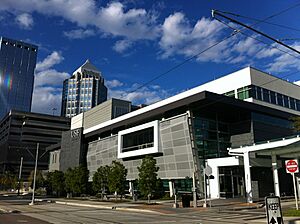
USF Health Research
USF Health includes colleges for medicine, nursing, pharmacy, and public health. Researchers here study many important health topics. These include cancer, diabetes, and Alzheimer's disease. The College of Nursing is top in Florida for research funding.
USF Health also has a training center for health professionals. In 2020, the Morsani College of Medicine moved to a new building in downtown Tampa.
Caring for the Environment
USF has a "gold rating" for being an environmentally-friendly campus. The university has many programs to help the environment. These include electric car charging stations and recycling programs.
USF aims to reduce its carbon emissions. Students can even propose projects to make the campus more sustainable. The nearly 20,000 trees on the Tampa campus help the environment a lot.
Several buildings on campus are "LEED certified." This means they were built to be very energy efficient.
Transportation Research
The Center for Urban Transportation Research (CUTR) studies transportation. It helps state and local governments with things like public transport and road safety.
Materials Simulation Lab
The Materials Simulation Laboratory uses supercomputers to study materials. They look at how materials behave under extreme heat and pressure.
Student Life
| Race and ethnicity | Total | ||
|---|---|---|---|
| White | 50.4% |
|
|
| Hispanic | 22.9% |
|
|
| Black | 9.1% |
|
|
| Other | 8.7% |
|
|
| Asian | 8.6% |
|
|
| Foreign national | 11.8% |
|
|
| Economic diversity | |||
| Low-income | 31% |
|
|
| Affluent | 69% |
|
|
The USF Tampa campus offers many services for students. These include housing, dining, and health services. Students can also join many clubs and activities.
Marshall Student Center
The Marshall Student Center opened in 2008. It is a four-story building with a large ballroom and auditorium. It has computer labs, study areas, and places to eat. This center is a main gathering spot for student life at USF.
Centre Gallery
The Centre Gallery is an art space run by students. It shows art from USF students, staff, and alumni. It is the only student-run art space like it in Florida.
Old Student Union
The first student union opened in 1960. It was called the University Center. It had a cafeteria, post office, and game room. This building was replaced by the new Marshall Student Center in 2008.
Bellini Center for Talent Development
In 2022, the Bellini Center for Talent Development was created. It helps business students with career services and internships.
Bull Statues
USF has nine life-size bronze bull statues across its campuses. Seven are on the Tampa campus. These statues are an important part of USF traditions. The three statues outside the Marshall Student Center are called the "Running of the Bulls."
Martin Luther King, Jr. Plaza
This plaza is a popular spot on the Tampa campus. It has a bust of Dr. King and a reflecting pool. Stone tablets with parts of his "I Have a Dream" speech are also there.
Botanical Gardens
The 15-acre botanical garden on the Tampa campus started in 1969. It has over 3,000 types of plants. These include fruit trees, orchids, and carnivorous plants. The garden is open to the public, and students can enter for free.
Castor Beach
Castor Beach is an artificial beach on campus. It has white sand from nearby Clearwater Beach. It's a popular place to relax, with hammocks and beach volleyball. Swimming in the lake is not allowed.
Student Housing
The USF Tampa campus has 14 residence halls. They can house over 6,500 students. There are different types of housing, including family housing and Greek Village for fraternities and sororities.
The St. Petersburg campus has three residence halls. The Sarasota-Manatee campus opened its first residence hall in 2024.
Campus Recreation
Gyms
The Campus Recreation Center on the Tampa campus is a large fitness facility. It has basketball courts, group fitness rooms, and a climbing wall. It also has an indoor running track and a swimming pool. Students can work out, take classes, and play sports here.
There are also smaller fitness centers around the Tampa campus.
Other Recreation
USF offers over 30 intramural sports. USF Riverfront Park is a recreational park for students and staff. It is on the Hillsborough River. Students can go canoeing, kayaking, and paddleboarding. The park also has a ropes course and a disk golf course.
Club Sports
USF has over 40 club sports teams. These teams compete against other schools. Club teams have won many national championships in sports like rugby, lacrosse, and ice hockey.
Harborwalk
Harborwalk is an area on the St. Petersburg campus. It connects the campus to downtown attractions like the Salvador Dalí Museum.
Student Involvement
USF has over 600 student organizations. Students can join groups for academics, hobbies, or cultural interests. The Center for Student Involvement plans events like Homecoming Week.
Fraternity and Sorority Life
There are 27 fraternities and 24 sororities at USF. They have their own residential area called Greek Village on the Tampa campus.
ROTC Programs
The USF Tampa campus offers three Reserve Officers' Training Corps (ROTC) programs: Air Force, Army, and Navy. USF is one of few universities to have all three. They are housed in a special building called the Joint Military Leadership Center (JMLC).
Students in ROTC can live together in a special dorm area. This helps them learn about military life and build friendships.
Student Government
The USF Student Government is run by students. It helps represent students' interests at the university and state levels. The Student Senate manages over $17 million in student fees each year.
University and Student Media
The Oracle is the student-run newspaper. It is published several times a week during semesters. It has won awards for its journalism.
WUSF (FM) is a public radio station owned by USF. It broadcasts news and jazz music. It is part of National Public Radio.
Bulls Radio is the student-run radio station. It broadcasts from the Marshall Student Center. Students can be DJs and reporters.
USF Traditions
USF's hand sign is "Horns Up." Fans use it at games for good luck or as a greeting.
After a Bulls sports team wins, the university's water tower is lit up green. It is usually lit with white lights. This lets everyone know about the win.
The Bull Market is a weekly outdoor market. It takes place every Wednesday outside the Marshall Student Center. Vendors and student groups showcase their products and services.
Trees are a big part of USF's identity. The first president, John Allen, wanted to plant many trees on campus. Today, students still plant trees every year on Arbor Day. Many roads and dorms are named after trees.
Homecoming
Homecoming festivities started in 1964. Events include a comedy show, a ball, a concert, a parade, and a carnival called Carni-BULL. These events lead up to the football game.
USF Week
In 2009, April 9 was declared USF Day. Now, the whole week of April 9 is celebrated as USF Week. It includes a pep rally, talent show, and a music festival called Bullstock.
Alma Mater
The university's alma mater song was written in 1960. It is played at the start of every graduation ceremony. The USF marching band also plays it after sports games.
Golden Brahman March
USF's fight song is called the Golden Brahman March. It is named after the university's original mascot, the Golden Brahman. New students learn the song during orientation.
Other Songs
"The Bull" (also known as Number 8) is a rallying song. It encourages fans to stand up and make the "Go Bulls" hand sign.
USF Sports
USF played its first college sports event in 1965. It joined the NCAA in 1968. USF now competes in NCAA Division I. The university has about 500 student-athletes.
USF teams have won many conference championships. The women's swimming team won an NCAA national championship in 1985. USF athletes have also won many individual national championships.
As of the 2024 Summer Olympics, 20 USF alumni have competed in the Olympic Games. Évelyne Viens was the first USF alum to win an Olympic medal as an athlete, winning gold in 2020.
Sports Teams
USF currently has 20 men's and women's sports teams:
| Men's sports | Women's sports |
|---|---|
| Baseball | Basketball |
| Basketball | Cross country |
| Cross country | Golf |
| Football | Lacrosse |
| Golf | Sailing |
| Soccer | Soccer |
| Tennis | Softball |
| Track & field† | Tennis |
| Track & field† | |
| Volleyball | |
| † – Track and field includes both indoor and outdoor. | |
USF will also add a women's beach volleyball team in the 2025–26 school year.
Sports Facilities
The USF Athletic District is on the eastern side of the Tampa campus. It is home to most of the Bulls' sports teams. It includes the Lee Roy Selmon Athletic Center and the Yuengling Center.
Lee Roy Selmon Athletic Center
This center is the main building for USF Athletics. It was named after Lee Roy Selmon, a famous football player and former USF Athletics Director. It has a strength and conditioning center, a sports medicine clinic, and an academic center for athletes.
Yuengling Center
The Yuengling Center is home to the men's and women's basketball teams and the women's volleyball team. It also hosts graduation ceremonies and concerts.
Raymond James Stadium
The USF football team plays at Raymond James Stadium. This is also the home of the NFL's Tampa Bay Buccaneers. The stadium is about 13 miles from campus.
Corbett Stadium
The USF men's and women's soccer teams play at Corbett Stadium on the Tampa campus. It has over 1,000 seats. The stadium also hosts the USF football team's spring game.
Spirit Squads
The USF Spirit Squads include the dance team, cheerleading squad, Rocky the Bull, and the Herd of Thunder marching band. They support the sports teams and also compete nationally. The co-ed cheer team won national championships in 2021, 2022, and 2023. The all-girl team won in 2024.
Rocky the Bull is the official mascot for USF. He appears at sports events and other university events.
The Herd of Thunder marching band has 370 members. They perform at football games. The pep band plays at basketball and volleyball games.
Famous People from USF
Many notable people have graduated from USF, including:
Academics
- Rhea Law, 1977, current President of the University of South Florida
- Tonjua Williams, M.A. 1996, president of St. Petersburg College
Athletes
- Tony La Russa, 1969, famous MLB manager and Hall of Famer
- Ed Baird, 1982, two-time America's Cup sailing champion
- Chucky Atkins, 1996, NBA point guard and NBA Champion
- Jason Pierre-Paul, 2009, NFL defensive end and two-time Super Bowl Champion
- Christiane Endler, 2014, famous soccer goalkeeper and FIFA Best Women's Goalkeeper of the Year
- Marquez Valdes-Scantling, 2017, NFL wide receiver and two-time Super Bowl Champion
- Évelyne Viens, 2020, Olympic gold medalist in soccer
Business Leaders
- George Reyes, 1976, former CFO of Google
- Robert B. Carter, 1990, co-chief executive officer and chief information officer of FedEx
Entertainers and Writers
- Lobo, 1965, singer/songwriter
- Hulk Hogan (attended), professional wrestler
- Richard King, 1976, sound engineer and four-time Academy Award winner
- Mark Consuelos, 1994, actor
- Grace Byers, 2006, actress
Military Leaders
- John Kirby, 1985, Rear Admiral and Press Secretary for the U.S. Department of Defense
Politicians and Activists
- H. Lee Moffitt, 1964, founder of the H. Lee Moffitt Cancer Center & Research Institute
- Pam Iorio, M.A. 2001, former Mayor of Tampa
Scientists
- Joanna Fowler, 1964, award-winning scientist at Brookhaven National Laboratory
- David Mearns, 1986, world record holder for deepest shipwreck found
Notable Faculty
- Autar Kaw, mechanical engineering professor and U.S. Professor of the Year award winner
- Robin Murphy, computer science
- Sten Vermund, public health
See also
 In Spanish: Universidad del Sur de Florida para niños
In Spanish: Universidad del Sur de Florida para niños


